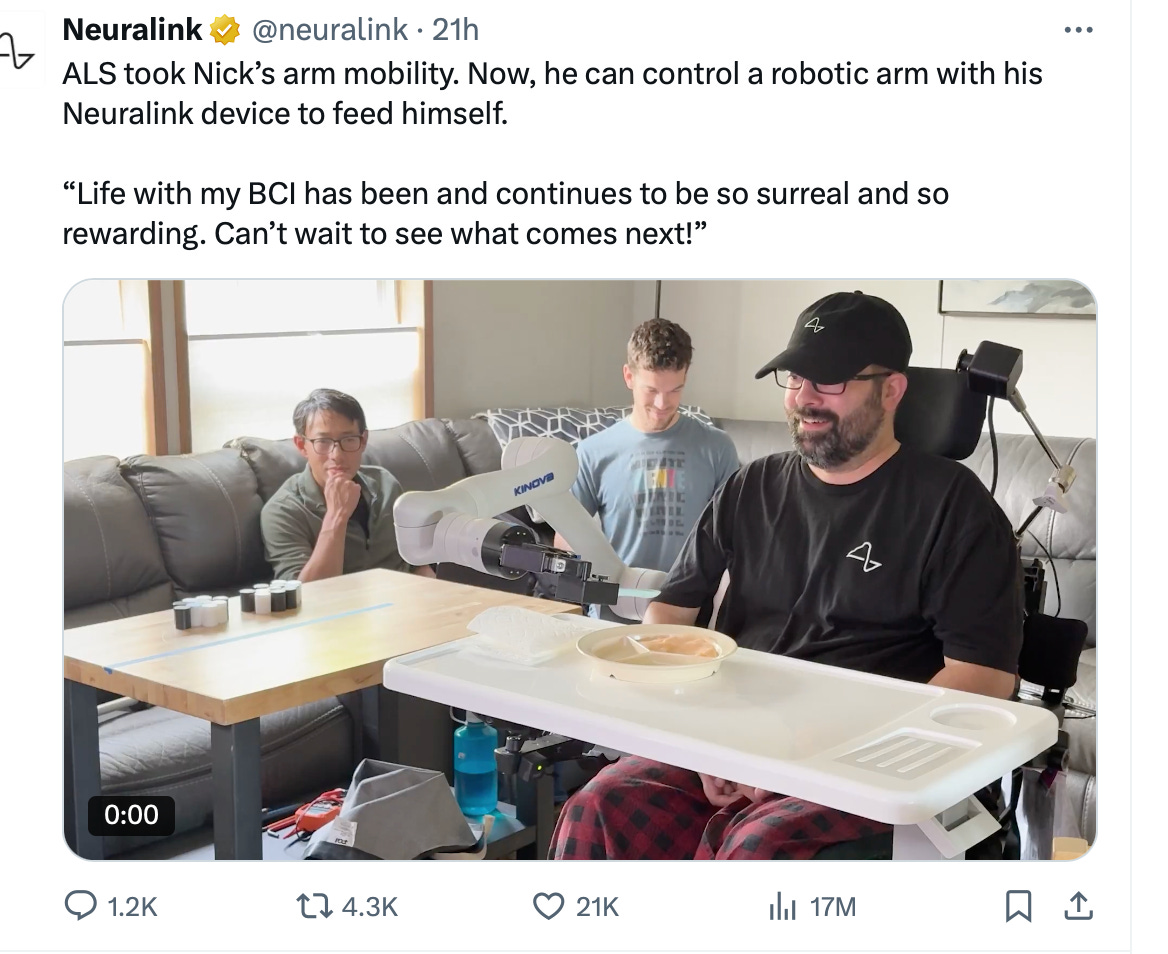October 11 2025. Elon Musk’s Neuralink is working well; they have just released a video of a man with Lou Gehrig’s disease feeding himself with a robot arm. This is a great boon for people suffering from paralysis.
https://x.com/neuralink/status/1976803020190236915
Neuralink is a brain-computer interface. The electrodes are implanted directly into the brain, and thereafter an adjustment period is required in which the interface learns what the patterns of neural activity are in order to effectively interpret the patterns and provide movement.
In an article published in Cureus by Brian Fiani et al1, the procedure is described in detail. It is quite interesting:
The Neuralink device contains an array of 96 small, flexible electrode threads with 32 independent arrays per thread totaling 3,072 electrodes per array [3,18]. Previous research with DBS has allowed of control of computer cursors, robotic limbs, and speech synthesizers using no more than 256 electrodes [4].
The use of individually implanted threads with many electrodes allows for an exponential increase of channel count over older brain-machine technology [2,4]. This large number of electrodes allows for an increase in accuracy, classification, and interpretation of brain electrical activity and an increase in the transfer of a high volume of data which can be read, amplified, and sent to a machine for interpretation, or can be used to send signals to the brain to help in the treatment of other brain disorders [3,4,18]. Musk and his team have experimented with different metal and polymer types and believe a biocompatible polyimide over a gold, thin film trace is the best option for the threads. Each thread features an electrode contact and traces as well as a sensor area to communicate with the custom chip to enable signal amplification. The threads of an array are two layers of a conductor covered with three layers of insulation and measure 4-6 µm in diameter with a length of 20 mm ending in a 16 × 50 µm2 loop to aid in insertion [3]. Due to the extreme small nature of the threads, threads are placed on a parylene-c film until ready for insertion [3]. The use of flexible, polymer threads over traditional rigid metals allows for decreased immune response and better biocompatibility while allowing the threads to shift with brain movement and avoid brain vasculature [3].
The use of many flexible threads poses a surgical limitation during implantation. The smaller size and flexibility of the individual threads make it difficult to implant and create a very slow and tedious process. To overcome this obstacle, Neuralink has created a surgical robot capable of individually inserting each thread with high precision and safety while avoiding surface vasculature and targeting specific brain zones. This surgical robot accomplishes this task using image stacking from six different light modules capable of illuminating at 405 nm, 525 nm, and 650 nm and stereoscopic cameras. The different light illuminations allow for better visualization of the small thread and cortex of the brain and allow the robot to accurately light up and locate the thread loop for threading the needle and for precise insertion of the thread into the cortical surface. The robot uses preselected insertion sites, depth tracking, and landmarks on the skull to avoid brain vasculature efficiently and precisely during insertion. Testing of this robot over 19 rat models demonstrated an average of 87.1% insertion success rate
Neuralink recently (October 5) submitted their first set of clinical data on three patients to the New England Journal of Medicine.
The possible uses of Neuralink also include mind-computer interfaces.
Elon Musk himself in the past expressed worries about AI — along with Apple’s Steve Wozniak, Yuval Noah Harari, and Silicon Valley AI developers, he signed an open letter in 2023 asking for a pause on AI development.
Nonetheless, one of the stated aims of Neuralink is to achieve a symbiosis between AI and the human mind.
Fiani B, Reardon T, Ayres B, Cline D, Sitto SR. An Examination of Prospective Uses and Future Directions of Neuralink: The Brain-Machine Interface. Cureus. 2021 Mar 30;13(3):e14192. doi: 10.7759/cureus.14192. PMID: 33936901; PMCID: PMC8083990. https://pmc.ncbi.nlm.nih.gov/articles/PMC8083990/


Well well... did the human race bite the apple?...or ? 🐍 serpent tempted Eve with knowledge.. Just bite the apple 🍎.?
Metaphorically speaking of course..
Or
. is this an evolution of direction by higher level 🤔 SECRET beings we humans are forbidden 🚫 🤔 to know of or engage with??? Showing us technologies that have always been around...
Im guessing the latter...
What say you?
This is how they draw us in ... 'Look at how these Demonic chip implants help the disabled!'.
This is the Transhuman dystopia, reaching the event horizon. Pretty soon, we're all just organic machines. "We'll upload your soul onto 'the Cloud' - and you can 'live' forever"... Sounds like Hell to me.